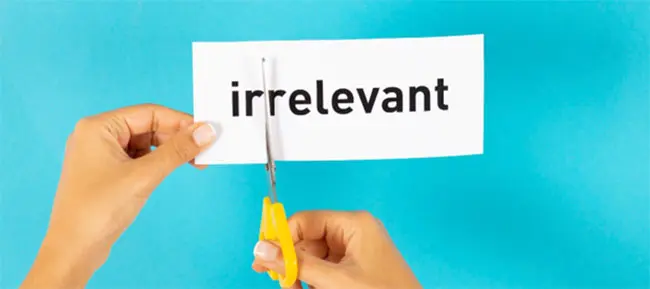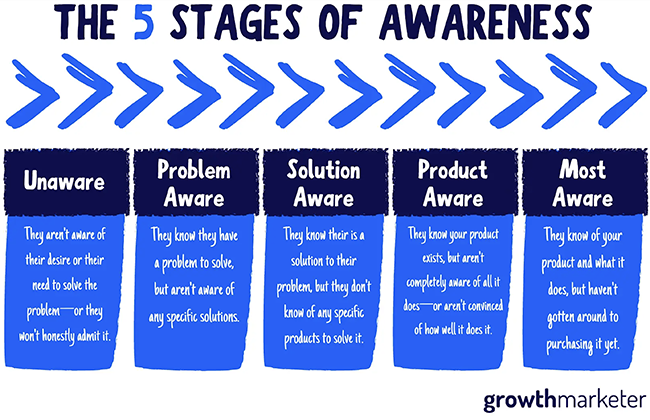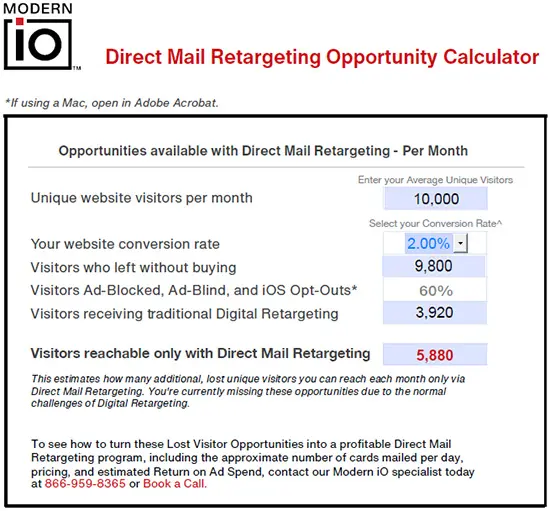How to Segment Your Website Visitors – and Max the ROI of Your Direct Mail Retargeting Program

Because 47% of customers say that just ONE irrelevant experience can push them to switch to a competitor.
Customer segmentation can help you avoid that “irrelevance” disaster – and keep all of your customers happily buying from YOU.
Customer segmentation is the process of dividing your customers and leads into meaningful groups based on their shared characteristics, behaviors, preferences, or needs so you can deliver more relevant experiences to them – which earns you their business.
In short, it’s a way to enable accurate customer targeting that helps you achieve the Holy Grail of marketing: Sending the right message, to the right person, at the right time.
SEGMENTATION MEANS MORE PROFIT
Done properly, customer segmentation also helps you to keep their business – becoming the foundation of relevance that drives customer retention, which explains more of a successful business’ profit than any other factor.
The customer segmentation process is easily performed with your customers and leads because you have their data in your CRM and marketing automation systems, email lists, and customer service calls.
And if you find your data lacking in completeness or depth, you can always survey or call your customers, or enrich their files with data from external sources.
But how in the world do you segment unconverted website visitors for Direct Mail Retargeting to better serve and convert them…
…when they aren’t in your CRM system since they haven’t opted in or purchased anything yet?
Great question.
The answer lies in the breadcrumbs your website visitors leave as they move around your site looking for the content that helps them better understand their problem and how your products and services can solve that for them.
The information your website visitors consumes gives you the clues to the most important question about them:
What do they already know and are aware of – about their problem AND your solution?
The right tool for that job is the 5 Stages of Awareness.
Properly segmenting and targeting your website visitors is such an important pillar of our model for high-return Direct Mail Retargeting that it’s Fundamental #3 in our proprietary Modern iO Direct Mail Retargeting program.

How to Segment Your Website Visitors
The 5 Stages of Awareness is the best tool to segment your website visitors and drive a more relevant experience for them – and maximize the ROI for your Direct Mail Retargeting.
Following the Stages of Awareness is so important in developing effective Direct Mail Retargeting program, that not following the Stages is on our list of the 5 Biggest Mistakes of Direct Mail Design that we revealed last month.
5 STAGES OF AWARENESS
To review, the Stages of Awareness were created by the real “Mad Men” copywriter Eugene Schwartz in his 1966 classic book Breakthrough Advertising.
There are five distinct stages – and think of these stages like a sales funnel. Each phase represents a buyer awareness level and is separated from the next by a psychological barrier.

Your job as the seller is to bridge the gap with your content, messaging and offers to move the prospect forward — or no sale happens.
It’s founded on the principle that you can’t make a prospect buy before they feel ready. It’s human nature to progress through the Stages and not skip any. So we want to work with it instead of against it – because it’s been proven to deliver a healthy boost in conversions.
When you consider your website visitors’ online behavior and the challenge of segmenting them into meaningful groups for more relevant brand experiences with you, the Stages of Awareness offers a powerful and convenient model to build your Direct Mail Retargeting strategy upon.
Importantly, the Stages of Awareness force you to recognize where your website visitor is at and get in sync with them – and also acknowledge that most aren’t ready to buy yet.
You want to align your Direct Mail Retargeting messaging and CTA with what visitors from each Stage ARE ready for so your outreach is as relevant as possible – and moves the visitor forward toward a possible conversion, even if they’re not ready to buy just yet:
STAGE OF AWARENESS | MESSAGING ALIGNMENT
1. UNAWARE – Highlight a problem that everyone has that your products fix
2. PROBLEM AWARE – Mirror their pain to meet them where they are, then guide them
3. SOLUTION AWARE – Highlight the benefits that favor your solution
4. PRODUCT AWARE – Sell! Expand on the benefits and compare why you’re the best
5. MOST AWARE – Deal time… make them an offer they can’t resist
Since people don’t visit websites they’re not interested in, we know that with Direct Mail Retargeting every website visitor already knows their problem and has come to your site to seek a solution – so they are all either Solution Aware, Product Aware or Most Aware.
THE CLICKS ARE THE CLUES
You can figure out what Stage each visitor is at based on which and how many pages they’ve visited on your site:
- If your website visitor only visited the Category page and not any Product Pages, then they’re likely Solution Aware. They are looking for top-level information on the solution, how it works, assessing if that can solve their problem, and maybe even comparing the solution to others. They usually aren’t close enough to purchase, so they don’t want to get bogged down in product details yet. So your Postcard design should focus on expanding on the benefits of your overall solution that favor you most.
- If your website visitor went to at least one Product page, and maybe checked out the About page, then they’re Product Aware. This visitor is ready to be sold and is nearing purchase, so let them know why you’re the best by expanding on the benefits that prove it. They stopped short of putting anything in their Cart, so they are moving close to Most Aware but likely not there yet.
- If the website visitor went to a Product page (often several, with prices), maybe the On Sale page, and put at least one product in his Cart and then abandoned it, he’s Most Aware – and is likely looking for a deal, and/or checking out the Shipping options. Your Postcard would highlight any scarcity or expiration, and perhaps make a more attractive offer – one that might include Free Shipping or other relevant discount to capture that new customer for a lifetime of purchases.
The Stages of Awareness help you segment AND sell better.
They take all of the marketing you’re already doing, and make it more effective – and are the website visitor segmentation answer that will maximize the ROI of your Direct Mail Retargeting program.

PUTTING IT ALL TOGETHER
It may seem straight-forward now that you’ve seen how segmentation with the Stages of Awareness works, but the final segmentation and retargeting strategy require you to consider a few other factors:
- What your retargeting goal is (conversion, engagement or just brand awareness)
- What your retargeting budget is
- How much traffic your site gets on which pages
- Whether you want to include current customers or not
- Whether you’re a B2C or B2B business
Let’s make this more real by examining the two most common client situations we encounter:
- A B2C e-commerce site that sells “quick decision” products or services also found in physical stores or specialty shops
- A B2B site that sells products or services that have higher price points and a longer sales cycle
B2C FOCUS
Most B2C e-commerce sites are focused on purchase conversion as their retargeting goal, which means you’ll retarget Solution-Aware and Most-Aware visitors with a strong sales message and an offer they can’t resist.
But since even the largest of brands have budgets to work within, you’ll want to prioritize your spend toward those most likely to convert.
- That likely includes all of your Abandoned Carts – but not necessarily if there are low-margin or constrained products you don’t want to spend more to promote. Your segmentation priorities should reflect whether you’re looking to drive new customers or profitability…and you can suppress existing customers for any period of time if you wish.
- The next highest priority should be targeting Product pages because these visitors are usually mentally “trying on” a purchase by checking out colors, sizes, availability, pricing, etc. If you have many Product pages and a tighter budget, then depending on your traffic to these pages, you may have to prioritize which Products get retargeted and which don’t. Prioritizing by profitability is the most common method.
- If you still have budget left after retargeting all the above high-intent groups, then the next priority should be visitors that went to “3 or More Pages.” This type of visitor is likely Solution Aware but is not quite ready to buy since they didn’t put anything in their Cart. You can change the number of required page visits to any level you’d like, but be aware that lowering it to “2 or More Pages” can reduce the ROI of your program.
B2B FOCUS
B2B sites that sell products or services that have higher price points and longer sales cycles are usually focused much more on engagement and less on conversion for their Direct Mail Retargeting.
That’s because the research and decision period can be months or longer. This means that B2B leads remain in the Product-Aware and Solution-Aware stages much longer than with B2C businesses, and the Direct Mail Retargeting offer may be content-oriented (webinar, PDF, etc.) in addition to some conversion (demo, trial, etc.).
Assessing which segments to prioritize will mean it’s not just those who are ready to convert now, since those will be few:
- The highest priority should be any page with a form on it or the Contact Us page. If you’ve placed a form on a page, it likely contains content that is driving your lead to a decision or a new Stage of Awareness. And your Contact Us page is a great indicator of prospects that are looking to take their engagement to the next level – especially for those who are want to reaching out, but don’t want to engage with a salesperson yet.
- Then come the key Product and Category pages that have information you know is an important differentiator or your product or service versus your competitors. Higher level feature/benefit pages are often too generic to target since the prospect hasn’t dug in to the deeper content to know enough to move to the next step.
- And finally you prioritize the About page and “X or More Pages” that fits how your prospect move through your customer journey. If you have a complex product like enterprise software that spans many pages, start with a 3-4-5 pages required and see the quality of response you get, then adjust accordingly.

ARE YOU SOLUTION AWARE?
Perhaps you’ve been taking in this article about how to segment website visitors for Direct Mail Retargeting, and see that it can done very effectively.
And now hearing that brands like Walmart, Art.com and Wayfair have been complementing their digital retargeting with Direct Mail Retargeting for some time, you know it can.
We explain the “Why” of all that in this post right here.
And at this point, you may be wondering…
How big is my website’s opportunity to access the unconverted website visitors that digital retargeting misses?
We’ve built a Lost Opportunity Calculator to help you easily figure that out.
Click the button to download the Calculator PDF (no email required) – and discover the number of lost website visitors your business could reach by diversifying your retargeting program.
Simply enter your business’ Unique Monthly Visitors and website Conversion Rate to customize it to your business’ profile.
The numbers make it plain to see why Direct Mail Retargeting has become one of the fastest-growing new marketing tools for online businesses today.

If you want to learn more about how to get your brand message back in front of past website visitors to drive them back to your site to buy – click here to choose a time convenient for you to speak with the head of our Customer Success team.

